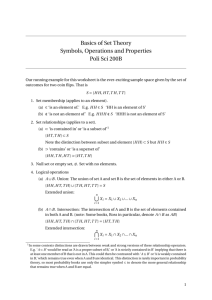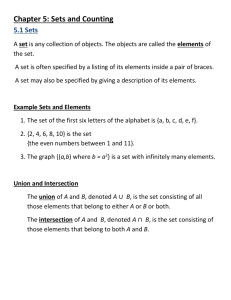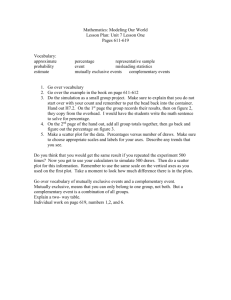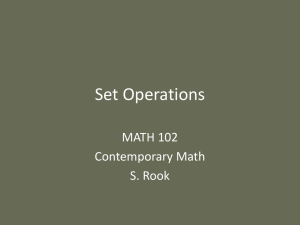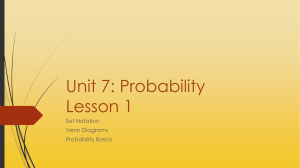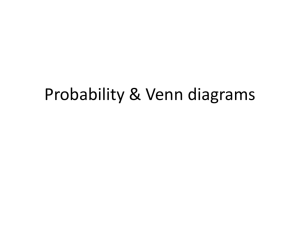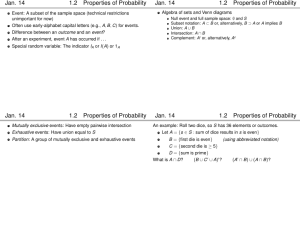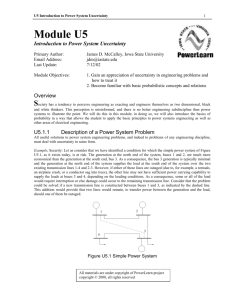10.7 Complementary events
advertisement
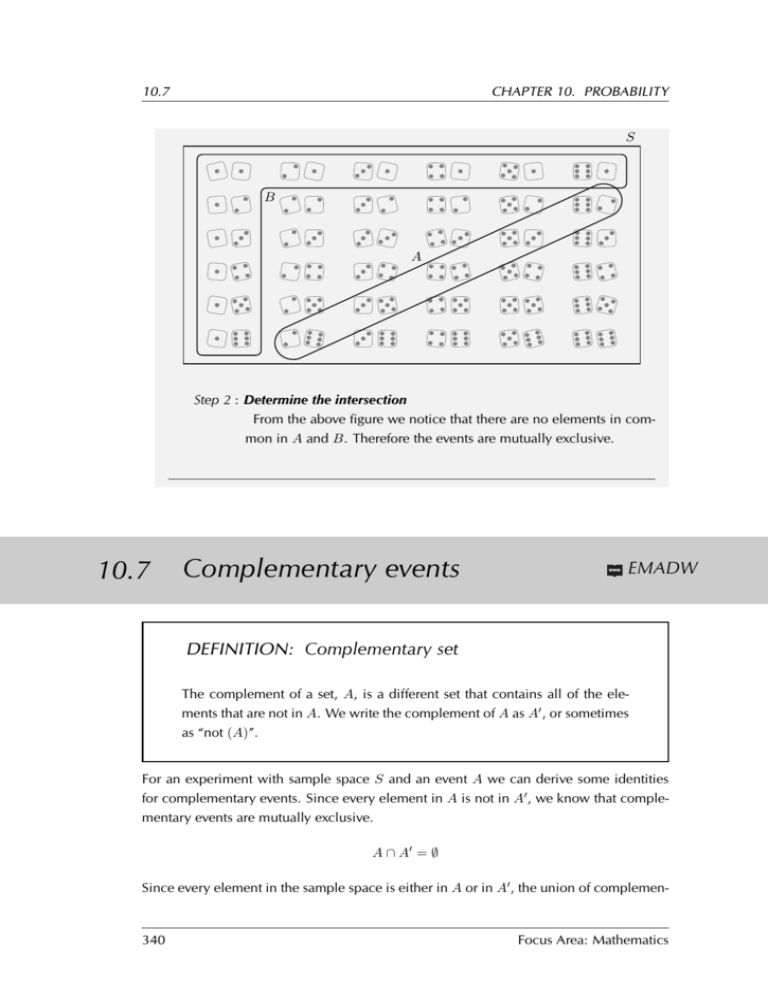
10.7 CHAPTER 10. PROBABILITY S B A Step 2 : Determine the intersection From the above figure we notice that there are no elements in common in A and B. Therefore the events are mutually exclusive. 10.7 Complementary events EMADW DEFINITION: Complementary set The complement of a set, A, is a different set that contains all of the elements that are not in A. We write the complement of A as A0 , or sometimes as “not (A)”. For an experiment with sample space S and an event A we can derive some identities for complementary events. Since every element in A is not in A0 , we know that complementary events are mutually exclusive. A ∩ A0 = ∅ Since every element in the sample space is either in A or in A0 , the union of complemen- 340 Focus Area: Mathematics CHAPTER 10. PROBABILITY 10.7 tary events covers the sample space. A ∪ A0 = S From the previous two identities, we also know that the probabilities of complementary events sum to 1. P (A) + P (A0 ) = P (A ∪ A0 ) = P (S) = 1 Video: VMcdl at www.everythingmaths.co.za Example 8: Reasoning with Venn diagrams QUESTION In a survey 70 people were questioned about which product they use: A or B or both. The report of the survey shows that 25 people use product A, 35 people use product B and 15 people use neither. Use a Venn diagram to work out how many people 1. use product A only 2. use product B only 3. use both product A and product B SOLUTION Step 1 : Summarise the sizes of the sample space, the event sets, their union and their intersection • We are told that 70 people were questioned, so the size of the sample space is n(S) = 70. • We are told that 25 people use product A, so n(A) = 25. • We are told that 35 people use product B, so n(B) = 35. • We are told that 15 people use neither product. This means that 70−15 = 55 people use at least one of the two products, so n(A ∪ B) = 55. Focus Area: Mathematics 341 10.7 CHAPTER 10. PROBABILITY • We are not told how many people use both products, so we have to work out the size of the intersection, A∩B, by using the identity P (A ∪ B) = P (A) + P (B) − P (A ∩ B) n(A ∪ B) n(A) n(B) n(A ∩ B) = + − n(S) n(S) n(S) n(S) 55 25 35 n(A ∩ B) = + − 70 70 70 70 ∴ n(A ∩ B) = 25 + 35 − 55 =5 Step 2 : Determine whether the events are mutually exclusive Since the intersection of the events, A ∩ B, is not empty, the events are not mutually exclusive. This means that their circles should overlap in the Venn diagram. Step 3 : Draw the Venn diagram and fill in the numbers S A B 20 5 30 15 Step 4 : Read off the answers 1. 20 people use product A only. 2. 30 people use product B only. 3. 5 people use both products. 342 Focus Area: Mathematics CHAPTER 10. PROBABILITY 10.7 Exercise 10 - 3 1. A box contains coloured blocks. The number of each colour is given in the following table. Colour Number of blocks Purple Orange White Pink 24 32 41 19 A block is selected randomly. What is the probability that the block will be: (a) purple (b) purple or white (c) pink and orange (d) not orange? 2. A small school has a class with children of various ages. The table gives the number of pupils of each age in the class. 3 years old 4 years old 5 years old Male 2 7 6 Female 6 5 4 If a pupil is selected at random what is the probability that the pupil will be: (a) a female (b) a 4 year old male (c) aged 3 or 4 (d) aged 3 and 4 (e) not 5 (f) either 3 or female? 3. Fiona has 85 labelled discs, which are numbered from 1 to 85. If a disc is selected at random what is the probability that the disc number: (a) ends with 5 (b) is a multiple of 3 (c) is a multiple of 6 (d) is number 65 (e) is not a multiple of 5 (f) is a multiple of 4 or 3 Focus Area: Mathematics 343 10.7 CHAPTER 10. PROBABILITY (g) is a multiple of 2 and 6 (h) is number 1? More practice (1.) 00in (2.) 00ip video solutions or help at www.everythingmaths.co.za (3.) 00iq Chapter 10 | Summary Summary presentation: VMdve at www.everythingmaths.co.za • An experiment refers to an uncertain process. • An outcome of an experiment is a single result of that experiment. • The sample space of an experiment is the set of all possible outcomes of that experiment. The sample space is denoted with the symbol S and the size of the sample space (the total number of possible outcomes) is denoted with n(S). • An event is a specific set of outcomes of an experiment that you are interested in. An event is denoted with the letter E and the number of outcomes in the event with n(E). • A probability is a real number between 0 and 1 that describes how likely it is that an event will occur. · A probability of 0 means that an event will never occur. · A probability of 1 means that an event will always occur. · A probability of 0,5 means that an event will occur half the time, or 1 time out of every 2. • A probability can also be written as a percentage or as a fraction. • The relative frequency of an event is defined as the number of times that the event occurs during experimental trials, divided by the total number of trials conducted. • The union of two sets is a new set that contains all of the elements that are in at least one of the two sets. The union is written as A ∪ B. • The intersection of two sets is a new set that contains all of the elements that are in both sets. The intersection is written as A ∩ B. 344 Focus Area: Mathematics
